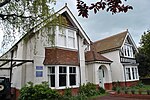Cavendish School, Eastbourne
1843 establishments in EnglandAcademies in East SussexEducational institutions established in 1843Primary schools in East SussexSchools in Eastbourne ... and 2 more
Secondary schools in East SussexUse British English from February 2023
The Cavendish School, commonly known as Cavendish School or Cavendish, is a coeducational All-through school with academy status, located in Eastbourne, East Sussex in England for children aged 2 to 16.The school converted to Academy on 1 August 2012. In September 2016 the school's Pre-School and primary phase building was opened and the Cavendish School became an All-through school.
Excerpt from the Wikipedia article Cavendish School, Eastbourne (License: CC BY-SA 3.0, Authors).Cavendish School, Eastbourne
Eldon Road,
Geographical coordinates (GPS) Address Phone number Website External links Nearby Places Show on map
Geographical coordinates (GPS)
| Latitude | Longitude |
|---|---|
| N 50.78039 ° | E 0.2606 ° |
Address
The Cavendish School
Eldon Road
BN21 1UE , Downside
England, United Kingdom
Open on Google Maps







